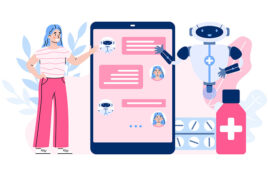
Geneticist Michael Snyder was wearing seven biosensors collecting data about his health when he noticed changes in his heart rate and oxygen level during a flight. When he later developed a fever, he suspected he had been infected with Lyme disease. Subsequent tests confirmed his suspicion. [Image courtesy Stanford University, Steve Fisch]
Wearable devices that can measure heart rate, activity, skin temperature and other biological variables have the potential to determine when someone has an infection, inflammation and insulin resistance, according to the Stanford researchers.
The research team used 2 billion measurements from a pool of 60 people. The measurements included continuous data collected from 1 to 7 commercially available biosensor devices and periodic data from blood chemistry lab tests, gene expressions and other measurements. Each device collected more than 250,000 measurements per day. The measurements included weight; heart rate; blood oxygen levels; skin temperature; activity like sleep, steps walking, biking and running; calories burned; acceleration and gamma ray and X-ray exposure.
If given a baseline of values for each participant, the study showed that the wearable devices were able to monitor irregular measurements and associate those irregularities with environmental conditions and illnesses. The patterns of those irregularities appear to correlate with different health problems.
Michael Snyder, professor and chair of genetics at Stanford, was the senior author of the study and one of the 60 participants. He wore 8 biosensors and noticed that he had an increased heart rate and low oxygen levels when he was flying one day. Knowing this is normal for flying, he expected his levels to return to normal. They didn’t return to normal in the time that they usually did and he ended up developing a fever and other symptoms. Knowing his symptoms, he suspected he had Lyme disease and asked a doctor for the Lyme disease fighting antibiotic doxycycline. The doctors tested him and discovered he was infected with the Lyme microorganism.
His biosensor was able to pick up signs of infection before he developed any other symptoms.
“Wearables helped make the initial diagnosis,” Snyder said.
Wearable devices were also able to recognize people who had an insulin resistance, a precursor to Type 2 diabetes. Researchers used glucose tests from 20 participants and concluded that 12 were insulin resistant. The team then designed an algorithm that combined their steps, daytime heart rate and the difference between daytime and nighttime heart rates. The algorithm processed the data and was able to successfully determine who was more likely to be insulin-resistant.
Researchers hope that this study will be a step toward continuous human health monitoring.
“We have more sensors on our cars than we have on human beings,” said Snyder.
The National Institutes of Health, the Department of Veterans Affairs, the Biomedical Data Science Initiative, and a gift from Bert and Cadence Forbes funded the research.
[Want to stay more on top of MDO content? Subscribe to our weekly e-newsletter.]




This is the new wave of the future of Health care. Empowering the patient to take control of one health status. Improve the literacy state of the patient; which will enable them to make decisions in collaboration and with guidance from their Physicians. With the amount of Data and research that is evolving; the key concept should be, analyze the information and deduce actionable knowledge to predict and prevent the disease rather than diagnose and cure.
Ranjit J Silva MD, MPH, MBA, FAAP, CPE
Thanks for the comment, Ranjit.